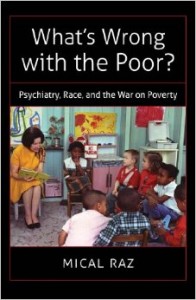Mical Raz, What’s Wrong with the Poor? Psychiatry, Race, and the War on Poverty (Chapel Hill: The University of North Carolina Press, 2013), 242 pages.
Review by Trevor Burrows
The cover image of Mical Raz’s What’s Wrong with the Poor? Psychiatry, Race, and the War on Poverty shows Lady Bird Johnson reading to a handful of mostly black children at a Head Start center. The First Lady also provides the book’s opening vignette, which describes how Johnson’s announcement of Project Head Start in the spring of 1965 included a number of characterizations of poverty that bordered on the outlandish, with Johnson suggesting that many poor children had never seen a flower or did not even know their own names. This juxtaposition of images recurs throughout Raz’s book, as her cast of well-meaning social workers, researchers, educators, and policy makers repeatedly (and often erroneously) interpreted the lives and habits of poor families through a lens of absolute deprivation. What’s Wrong with the Poor? examines how the broad discourse of “cultural deprivation” provided the framework through which poverty was conceptualized as a problem of deficiency and deprivation throughout the 1960s. Raz argues that the basic tenets of cultural deprivation theory underwrote many of the assumptions and programs at the core of the War on Poverty.
cast of well-meaning social workers, researchers, educators, and policy makers repeatedly (and often erroneously) interpreted the lives and habits of poor families through a lens of absolute deprivation. What’s Wrong with the Poor? examines how the broad discourse of “cultural deprivation” provided the framework through which poverty was conceptualized as a problem of deficiency and deprivation throughout the 1960s. Raz argues that the basic tenets of cultural deprivation theory underwrote many of the assumptions and programs at the core of the War on Poverty.
Initially employed by social scientists in the early 1960s, theories of cultural deprivation interpreted poverty as a pathology rooted in a range of social, cultural, and environmental inadequacies. These theories proved especially influential in shaping ideas of how poverty affected early childhood development. Cultural deprivation theory encouraged researchers, policymakers, and social workers to interpret the conditions of poverty in terms of what was purportedly missing in the family structures, environmental conditions, and daily living habits of poor families, and thus gave license to the intervention of middle-class values into the lives of the poor. Potential deficiencies included everything from the absence of a parent to the wrong kind of parenting style, from the improper arrangement of a kitchen to the wrong types or colors of toys in the home, or even inadequate exposure to language. As these examples suggest, theories of deprivation cloaked classist and racist assumptions about disorder and irresponsibility amongst the poor in terminology that appeared objective. Indeed, although cultural deprivation theory frequently utilized “color-blind” terminology, researchers and policymakers overwhelmingly targeted poverty amongst African Americans in urban environments. The popularity of these theories, along with connections between social scientists, politicians, and program administrators, meant that many of the decade’s most important documents and programs—from various community action programs and early educational endeavors, such as Project Head Start, to documents like the Moynihan Report and the work of the Kerner Commission—bore the language and assumptions of cultural deprivation as both a root cause and a recurring symptom of the cycles of poverty.
Although there is a sizable literature exploring the implications of War on Poverty programs in terms of race and class, Raz’s work makes several unique contributions to the topic. First, Raz argues that “cultural deprivation” was an ambiguous and often ill-founded elaboration upon early research in sensory deprivation and maternal deprivation. Sensory and maternal deprivation had come of age as areas of psychological, psychoanalytical, and early childhood research in the mid- to late-1950s; such research oftenfocused on the effects of certain types of stimuli and care on early childhood development. It did not take long, however, for studies from these areas to be taken up across disciplinary lines, often with relatively little regard for the specific experimental and evidentiary aspects of earlier research. At the same time, theories of sensory and maternal deprivation were bundled and conflated with other forms of deprivation theory into a larger all-encompassing theory: “cultural deprivation.” Through close analysis of the citations and publications of those employed the idea of cultural deprivation, Raz demonstrates that although “empirical evidence regarding the nature of cultural deprivation was assumed to be available and was cited by and exchanged among politicians and experts,”in reality “no such data existed” (52, emphasis added). Theories of cultural deprivation that had a substantial impact on the War on Poverty’s conceptualization of poverty were largely based on the misapplication of earlier scientific research.
Another contribution comes from Raz’s recognition that cultural deprivation theory “was not an inevitable interpretation of scientific findings but rather a politically motivated conceptual framework” (73). Although attention is paid to concrete connections between the administrators behind the War on Poverty and cultural deprivation theorists, what stands out is Raz’s attention to how cultural deprivation theory was so well-received while it boasted little solid evidence. To this end, Raz highlights the slippery conceptual and semantic mechanics at work in retooling and translating earlier research toward new ends. The inclusive discourse of cultural deprivation allowed for every form of deprivation to be understood as an analogy or kin of every other form of deprivation. Nutritional, linguistic, environmental, sensory, and maternal deprivation — connections were made between these ideas whether justified or not. These and other processes obscured how cultural deprivation theory allowed for the transformation of deeply subjective notions of cultural lack into the objective language of social science and public policy.
Raz’s unwavering focus on the origins, deployment, and impact of deprivation theory sometimes means that less attention is paid to larger matters of historical context. For while the reader comes away from the text with a substantial understanding of deprivation theory and its effects upon various War on Poverty programs, little attention is paid to where ideas of deprivation fit in the longer narratives of social work and poverty, not to mention histories of science and race, or federal welfare initiatives and the social sciences. There is some effort to demonstrate how and why cultural deprivation theories fall from grace by the mid-70s, but there is very little sense of what came before cultural deprivation theory. While providing an excellent view of how cultural deprivation theory developed and what it enabled in terms of policy, Raz does less to contextualize the theory’s emergence and prominence from longer historical points-of-view.
Nevertheless, What’s Wrong With the Poor? stands out as an exceptional investigation into how a constellation of ideas, some with relatively little scientific grounding, gained credibility and traction among researchers, policymakers, and the broader American public. Indeed, although historians of the mid-twentieth century will find Raz’s text to be an interesting perspective from which we might revisit race and class in relation to the War on Poverty and mid-century liberalism, many will find Raz’s text interesting as a case study in how new and rather untested ideas can so quickly find audience and influence within a given cultural moment. The book clearly highlights the significance of cultural deprivation theory in the conception and application of numerous programs associated with the War on Poverty, from early education initiatives to interpretations of urban violence. At the same time, it demonstrates how cultural deprivation theory served a need specific to the period, insofar as it appeared to answer uncomfortable questions while preserving structures of racialized privilege and power in difficult, transformative times. Raz’s work hints not just at the power of ideas to both affect and resist change, but also at the complicated mechanisms that enable ideas to do both.

Trevor Burrows is a PhD student at Purdue University. His areas of interest include American religious history, twentieth-century social and political movements, and the long 1960s. His dissertation, set in Chicago, concerns the place and impact of religious institutions and thought among various “Movement” groups of the 1960s and ’70s.

4 Thoughts on this Post
S-USIH Comment Policy
We ask that those who participate in the discussions generated in the Comments section do so with the same decorum as they would in any other academic setting or context. Since the USIH bloggers write under our real names, we would prefer that our commenters also identify themselves by their real name. As our primary goal is to stimulate and engage in fruitful and productive discussion, ad hominem attacks (personal or professional), unnecessary insults, and/or mean-spiritedness have no place in the USIH Blog’s Comments section. Therefore, we reserve the right to remove any comments that contain any of the above and/or are not intended to further the discussion of the topic of the post. We welcome suggestions for corrections to any of our posts. As the official blog of the Society of US Intellectual History, we hope to foster a diverse community of scholars and readers who engage with one another in discussions of US intellectual history, broadly understood.
Thanks for this review, for what seems like a very great book. I had heard about it before hand so this summary was nice to read and spurs me on to getting a hold of the book itself.
Thank you — it was a pleasure to review!
I don’t know whether anyone has done a similar study of earlier views of the rural poor, such as TR’s Country Life Commission and the New Deal’s Resettlement Administration/Farm Security Administration. Comparing and contrasting such approaches with those Raz has analyzed could be interesting.
Also in case you don’t already know if you are looking for that longer context Alice O’Connor’s Poverty Knowledge is pretty much the encylopedic reference point for almost all that stuff. It is some deep policy history though so doesn’t connect back much to larger themes but as for a very detailed account of social science on poverty over about 100 years it can’t be beat.